Evaluating Mattel: A Case Study on Business Ethics and Toy Safety
VerifiedAdded on 2023/03/30
|11
|3142
|135
Case Study
AI Summary
This case study delves into the challenges faced by Mattel, a leading toy company, regarding customer dissatisfaction due to hazardous products. It examines Mattel's actions concerning children's toy safety, focusing on corporate social responsibility and ethical conduct. The study discusses the importance of designing appropriate toy models, using adequate raw materials, and employing qualified teams for product safety. It also highlights the roles of government regulators, consumer advocates, and standard-setting organizations in ensuring toy safety. Furthermore, the study emphasizes the society's role in protecting children from hazardous toys through awareness, careful purchasing decisions, and stakeholder safety measures. The case study concludes by suggesting improvements in production, supply chain management, and adherence to safety regulations to prevent future incidents.

Case Study
Paraphrase This Document
Need a fresh take? Get an instant paraphrase of this document with our AI Paraphraser
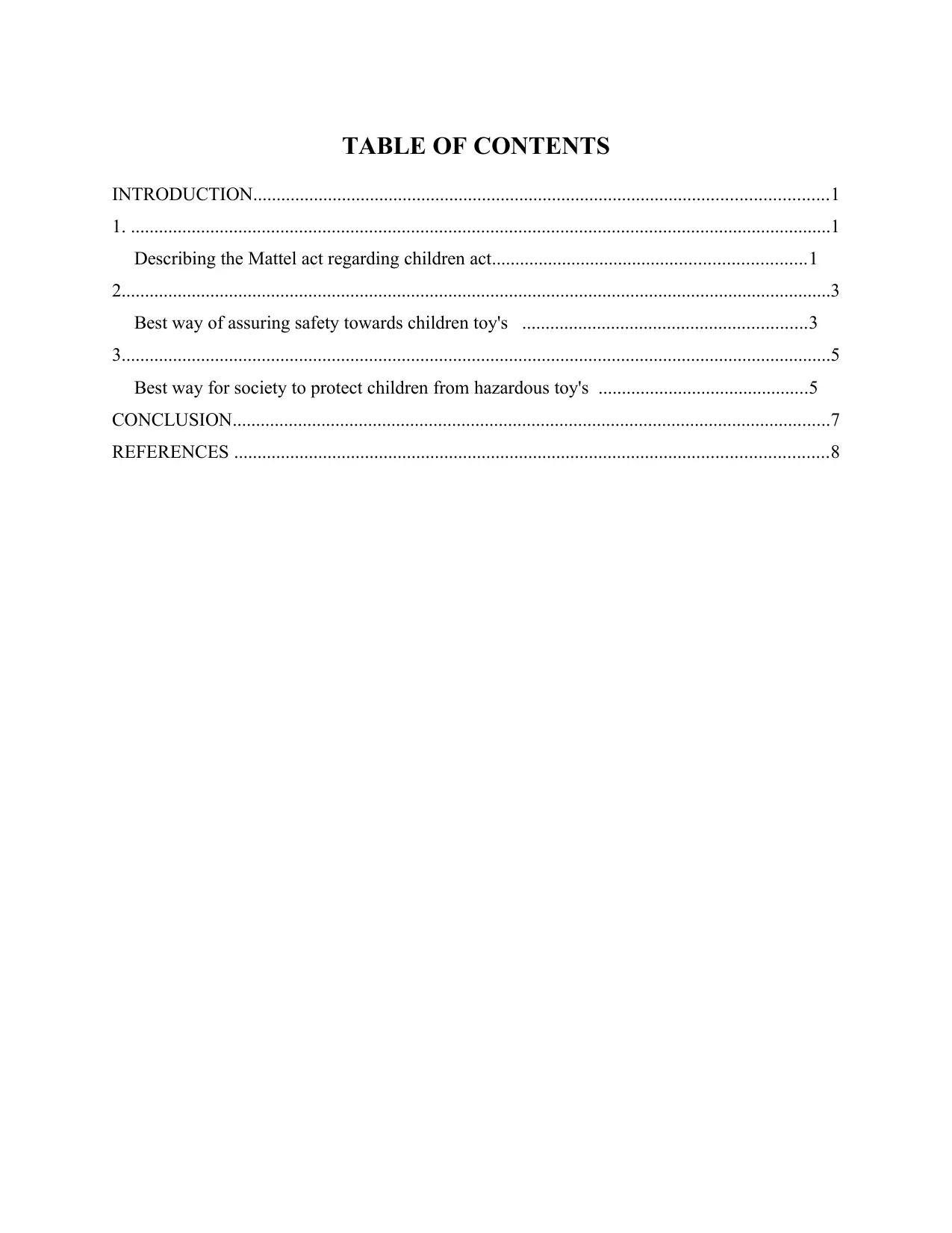
TABLE OF CONTENTS
INTRODUCTION...........................................................................................................................1
1. ......................................................................................................................................................1
Describing the Mattel act regarding children act...................................................................1
2........................................................................................................................................................3
Best way of assuring safety towards children toy's .............................................................3
3........................................................................................................................................................5
Best way for society to protect children from hazardous toy's .............................................5
CONCLUSION................................................................................................................................7
REFERENCES ...............................................................................................................................8
INTRODUCTION...........................................................................................................................1
1. ......................................................................................................................................................1
Describing the Mattel act regarding children act...................................................................1
2........................................................................................................................................................3
Best way of assuring safety towards children toy's .............................................................3
3........................................................................................................................................................5
Best way for society to protect children from hazardous toy's .............................................5
CONCLUSION................................................................................................................................7
REFERENCES ...............................................................................................................................8
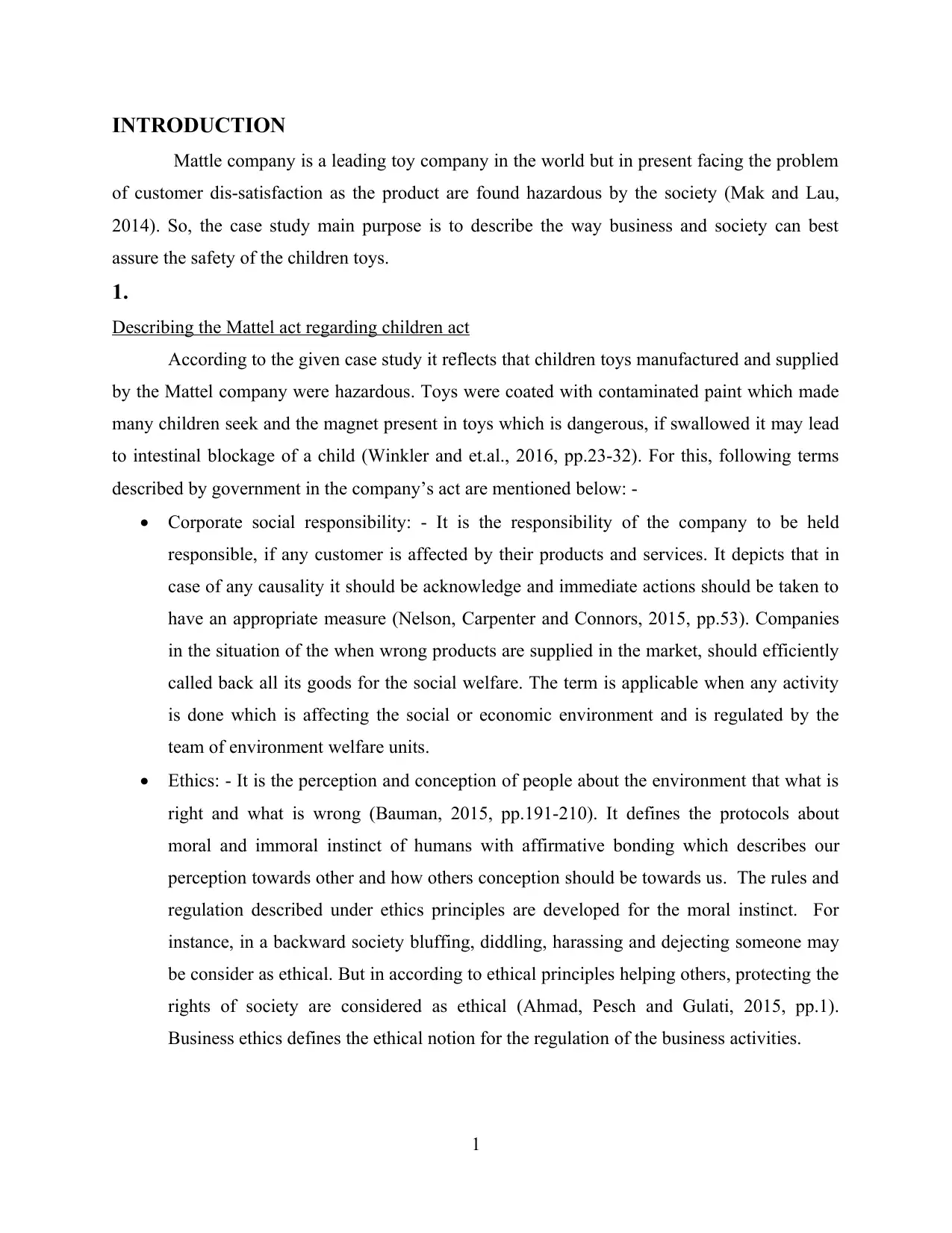
INTRODUCTION
Mattle company is a leading toy company in the world but in present facing the problem
of customer dis-satisfaction as the product are found hazardous by the society (Mak and Lau,
2014). So, the case study main purpose is to describe the way business and society can best
assure the safety of the children toys.
1.
Describing the Mattel act regarding children act
According to the given case study it reflects that children toys manufactured and supplied
by the Mattel company were hazardous. Toys were coated with contaminated paint which made
many children seek and the magnet present in toys which is dangerous, if swallowed it may lead
to intestinal blockage of a child (Winkler and et.al., 2016, pp.23-32). For this, following terms
described by government in the company’s act are mentioned below: -
Corporate social responsibility: - It is the responsibility of the company to be held
responsible, if any customer is affected by their products and services. It depicts that in
case of any causality it should be acknowledge and immediate actions should be taken to
have an appropriate measure (Nelson, Carpenter and Connors, 2015, pp.53). Companies
in the situation of the when wrong products are supplied in the market, should efficiently
called back all its goods for the social welfare. The term is applicable when any activity
is done which is affecting the social or economic environment and is regulated by the
team of environment welfare units.
Ethics: - It is the perception and conception of people about the environment that what is
right and what is wrong (Bauman, 2015, pp.191-210). It defines the protocols about
moral and immoral instinct of humans with affirmative bonding which describes our
perception towards other and how others conception should be towards us. The rules and
regulation described under ethics principles are developed for the moral instinct. For
instance, in a backward society bluffing, diddling, harassing and dejecting someone may
be consider as ethical. But in according to ethical principles helping others, protecting the
rights of society are considered as ethical (Ahmad, Pesch and Gulati, 2015, pp.1).
Business ethics defines the ethical notion for the regulation of the business activities.
1
Mattle company is a leading toy company in the world but in present facing the problem
of customer dis-satisfaction as the product are found hazardous by the society (Mak and Lau,
2014). So, the case study main purpose is to describe the way business and society can best
assure the safety of the children toys.
1.
Describing the Mattel act regarding children act
According to the given case study it reflects that children toys manufactured and supplied
by the Mattel company were hazardous. Toys were coated with contaminated paint which made
many children seek and the magnet present in toys which is dangerous, if swallowed it may lead
to intestinal blockage of a child (Winkler and et.al., 2016, pp.23-32). For this, following terms
described by government in the company’s act are mentioned below: -
Corporate social responsibility: - It is the responsibility of the company to be held
responsible, if any customer is affected by their products and services. It depicts that in
case of any causality it should be acknowledge and immediate actions should be taken to
have an appropriate measure (Nelson, Carpenter and Connors, 2015, pp.53). Companies
in the situation of the when wrong products are supplied in the market, should efficiently
called back all its goods for the social welfare. The term is applicable when any activity
is done which is affecting the social or economic environment and is regulated by the
team of environment welfare units.
Ethics: - It is the perception and conception of people about the environment that what is
right and what is wrong (Bauman, 2015, pp.191-210). It defines the protocols about
moral and immoral instinct of humans with affirmative bonding which describes our
perception towards other and how others conception should be towards us. The rules and
regulation described under ethics principles are developed for the moral instinct. For
instance, in a backward society bluffing, diddling, harassing and dejecting someone may
be consider as ethical. But in according to ethical principles helping others, protecting the
rights of society are considered as ethical (Ahmad, Pesch and Gulati, 2015, pp.1).
Business ethics defines the ethical notion for the regulation of the business activities.
1
⊘ This is a preview!⊘
Do you want full access?
Subscribe today to unlock all pages.

Trusted by 1+ million students worldwide
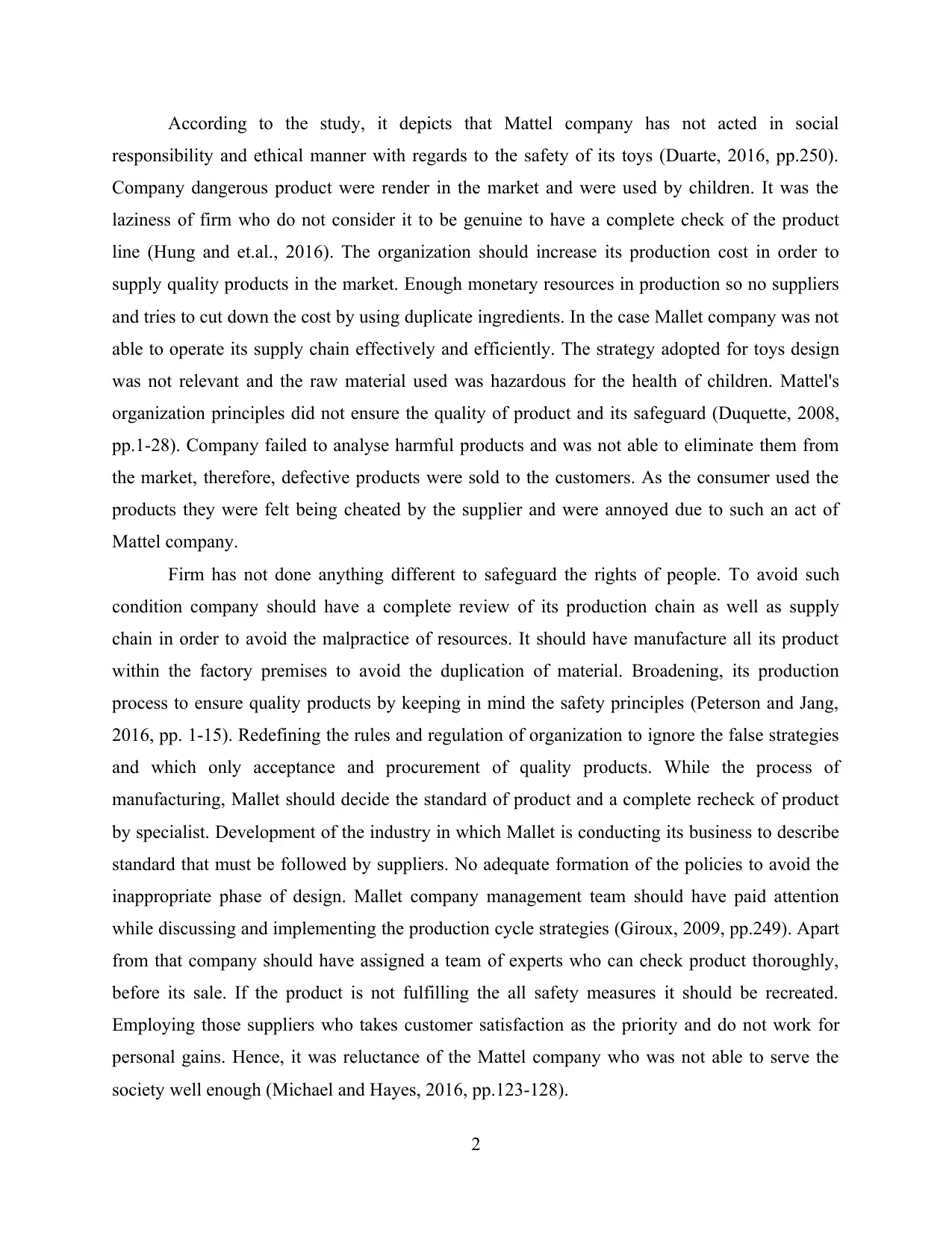
According to the study, it depicts that Mattel company has not acted in social
responsibility and ethical manner with regards to the safety of its toys (Duarte, 2016, pp.250).
Company dangerous product were render in the market and were used by children. It was the
laziness of firm who do not consider it to be genuine to have a complete check of the product
line (Hung and et.al., 2016). The organization should increase its production cost in order to
supply quality products in the market. Enough monetary resources in production so no suppliers
and tries to cut down the cost by using duplicate ingredients. In the case Mallet company was not
able to operate its supply chain effectively and efficiently. The strategy adopted for toys design
was not relevant and the raw material used was hazardous for the health of children. Mattel's
organization principles did not ensure the quality of product and its safeguard (Duquette, 2008,
pp.1-28). Company failed to analyse harmful products and was not able to eliminate them from
the market, therefore, defective products were sold to the customers. As the consumer used the
products they were felt being cheated by the supplier and were annoyed due to such an act of
Mattel company.
Firm has not done anything different to safeguard the rights of people. To avoid such
condition company should have a complete review of its production chain as well as supply
chain in order to avoid the malpractice of resources. It should have manufacture all its product
within the factory premises to avoid the duplication of material. Broadening, its production
process to ensure quality products by keeping in mind the safety principles (Peterson and Jang,
2016, pp. 1-15). Redefining the rules and regulation of organization to ignore the false strategies
and which only acceptance and procurement of quality products. While the process of
manufacturing, Mallet should decide the standard of product and a complete recheck of product
by specialist. Development of the industry in which Mallet is conducting its business to describe
standard that must be followed by suppliers. No adequate formation of the policies to avoid the
inappropriate phase of design. Mallet company management team should have paid attention
while discussing and implementing the production cycle strategies (Giroux, 2009, pp.249). Apart
from that company should have assigned a team of experts who can check product thoroughly,
before its sale. If the product is not fulfilling the all safety measures it should be recreated.
Employing those suppliers who takes customer satisfaction as the priority and do not work for
personal gains. Hence, it was reluctance of the Mattel company who was not able to serve the
society well enough (Michael and Hayes, 2016, pp.123-128).
2
responsibility and ethical manner with regards to the safety of its toys (Duarte, 2016, pp.250).
Company dangerous product were render in the market and were used by children. It was the
laziness of firm who do not consider it to be genuine to have a complete check of the product
line (Hung and et.al., 2016). The organization should increase its production cost in order to
supply quality products in the market. Enough monetary resources in production so no suppliers
and tries to cut down the cost by using duplicate ingredients. In the case Mallet company was not
able to operate its supply chain effectively and efficiently. The strategy adopted for toys design
was not relevant and the raw material used was hazardous for the health of children. Mattel's
organization principles did not ensure the quality of product and its safeguard (Duquette, 2008,
pp.1-28). Company failed to analyse harmful products and was not able to eliminate them from
the market, therefore, defective products were sold to the customers. As the consumer used the
products they were felt being cheated by the supplier and were annoyed due to such an act of
Mattel company.
Firm has not done anything different to safeguard the rights of people. To avoid such
condition company should have a complete review of its production chain as well as supply
chain in order to avoid the malpractice of resources. It should have manufacture all its product
within the factory premises to avoid the duplication of material. Broadening, its production
process to ensure quality products by keeping in mind the safety principles (Peterson and Jang,
2016, pp. 1-15). Redefining the rules and regulation of organization to ignore the false strategies
and which only acceptance and procurement of quality products. While the process of
manufacturing, Mallet should decide the standard of product and a complete recheck of product
by specialist. Development of the industry in which Mallet is conducting its business to describe
standard that must be followed by suppliers. No adequate formation of the policies to avoid the
inappropriate phase of design. Mallet company management team should have paid attention
while discussing and implementing the production cycle strategies (Giroux, 2009, pp.249). Apart
from that company should have assigned a team of experts who can check product thoroughly,
before its sale. If the product is not fulfilling the all safety measures it should be recreated.
Employing those suppliers who takes customer satisfaction as the priority and do not work for
personal gains. Hence, it was reluctance of the Mattel company who was not able to serve the
society well enough (Michael and Hayes, 2016, pp.123-128).
2
Paraphrase This Document
Need a fresh take? Get an instant paraphrase of this document with our AI Paraphraser
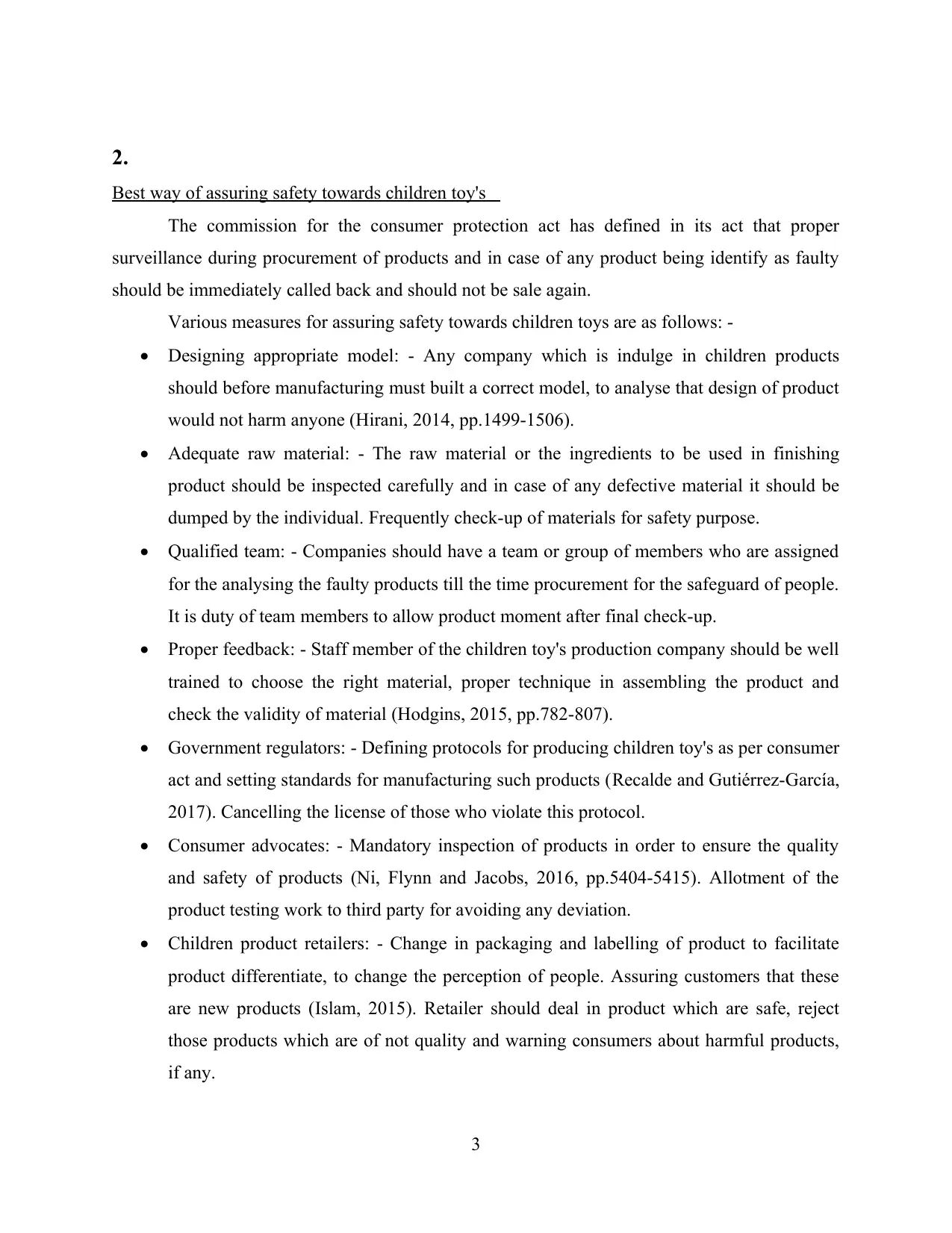
2.
Best way of assuring safety towards children toy's
The commission for the consumer protection act has defined in its act that proper
surveillance during procurement of products and in case of any product being identify as faulty
should be immediately called back and should not be sale again.
Various measures for assuring safety towards children toys are as follows: -
Designing appropriate model: - Any company which is indulge in children products
should before manufacturing must built a correct model, to analyse that design of product
would not harm anyone (Hirani, 2014, pp.1499-1506).
Adequate raw material: - The raw material or the ingredients to be used in finishing
product should be inspected carefully and in case of any defective material it should be
dumped by the individual. Frequently check-up of materials for safety purpose.
Qualified team: - Companies should have a team or group of members who are assigned
for the analysing the faulty products till the time procurement for the safeguard of people.
It is duty of team members to allow product moment after final check-up.
Proper feedback: - Staff member of the children toy's production company should be well
trained to choose the right material, proper technique in assembling the product and
check the validity of material (Hodgins, 2015, pp.782-807).
Government regulators: - Defining protocols for producing children toy's as per consumer
act and setting standards for manufacturing such products (Recalde and Gutiérrez-García,
2017). Cancelling the license of those who violate this protocol.
Consumer advocates: - Mandatory inspection of products in order to ensure the quality
and safety of products (Ni, Flynn and Jacobs, 2016, pp.5404-5415). Allotment of the
product testing work to third party for avoiding any deviation.
Children product retailers: - Change in packaging and labelling of product to facilitate
product differentiate, to change the perception of people. Assuring customers that these
are new products (Islam, 2015). Retailer should deal in product which are safe, reject
those products which are of not quality and warning consumers about harmful products,
if any.
3
Best way of assuring safety towards children toy's
The commission for the consumer protection act has defined in its act that proper
surveillance during procurement of products and in case of any product being identify as faulty
should be immediately called back and should not be sale again.
Various measures for assuring safety towards children toys are as follows: -
Designing appropriate model: - Any company which is indulge in children products
should before manufacturing must built a correct model, to analyse that design of product
would not harm anyone (Hirani, 2014, pp.1499-1506).
Adequate raw material: - The raw material or the ingredients to be used in finishing
product should be inspected carefully and in case of any defective material it should be
dumped by the individual. Frequently check-up of materials for safety purpose.
Qualified team: - Companies should have a team or group of members who are assigned
for the analysing the faulty products till the time procurement for the safeguard of people.
It is duty of team members to allow product moment after final check-up.
Proper feedback: - Staff member of the children toy's production company should be well
trained to choose the right material, proper technique in assembling the product and
check the validity of material (Hodgins, 2015, pp.782-807).
Government regulators: - Defining protocols for producing children toy's as per consumer
act and setting standards for manufacturing such products (Recalde and Gutiérrez-García,
2017). Cancelling the license of those who violate this protocol.
Consumer advocates: - Mandatory inspection of products in order to ensure the quality
and safety of products (Ni, Flynn and Jacobs, 2016, pp.5404-5415). Allotment of the
product testing work to third party for avoiding any deviation.
Children product retailers: - Change in packaging and labelling of product to facilitate
product differentiate, to change the perception of people. Assuring customers that these
are new products (Islam, 2015). Retailer should deal in product which are safe, reject
those products which are of not quality and warning consumers about harmful products,
if any.
3
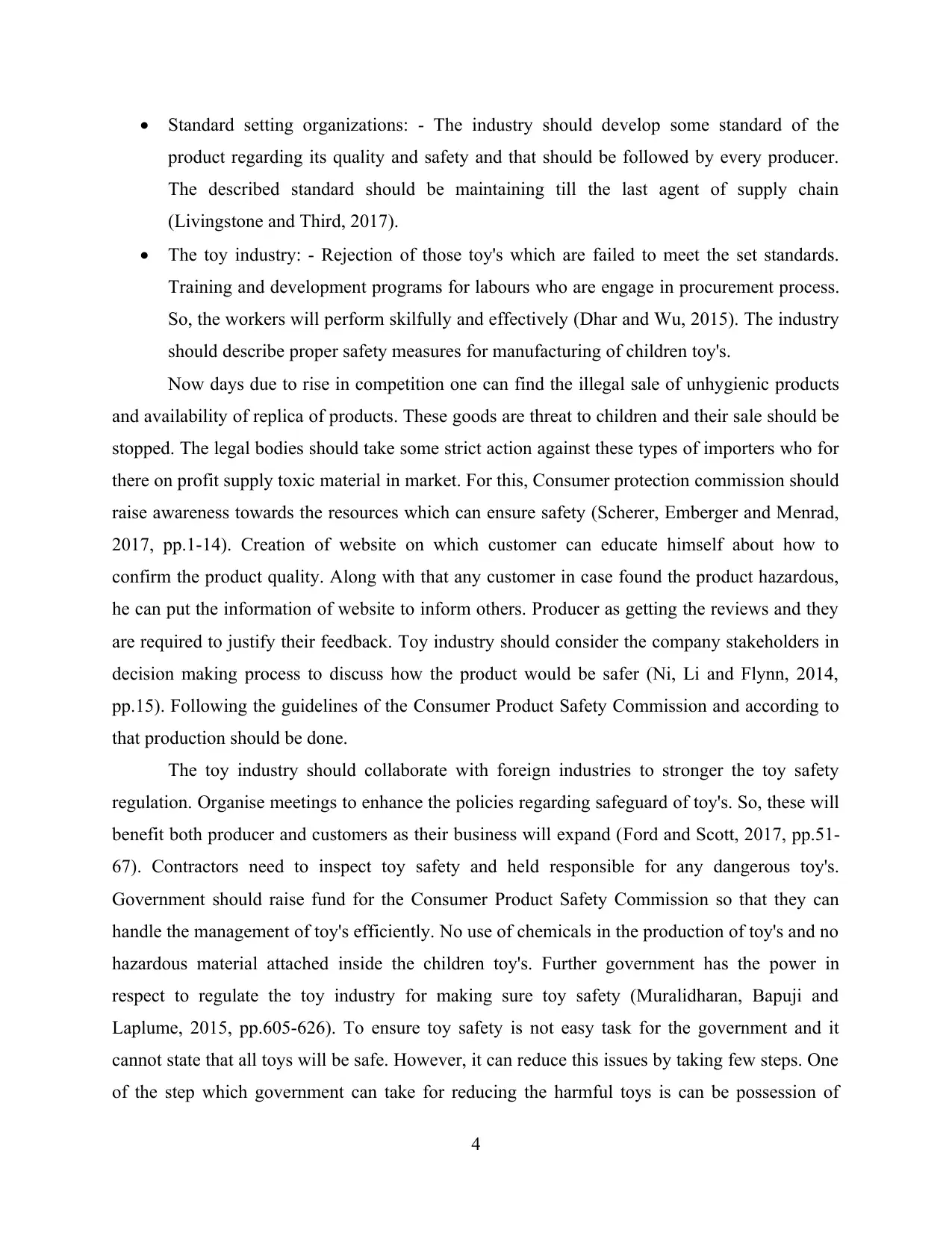
Standard setting organizations: - The industry should develop some standard of the
product regarding its quality and safety and that should be followed by every producer.
The described standard should be maintaining till the last agent of supply chain
(Livingstone and Third, 2017).
The toy industry: - Rejection of those toy's which are failed to meet the set standards.
Training and development programs for labours who are engage in procurement process.
So, the workers will perform skilfully and effectively (Dhar and Wu, 2015). The industry
should describe proper safety measures for manufacturing of children toy's.
Now days due to rise in competition one can find the illegal sale of unhygienic products
and availability of replica of products. These goods are threat to children and their sale should be
stopped. The legal bodies should take some strict action against these types of importers who for
there on profit supply toxic material in market. For this, Consumer protection commission should
raise awareness towards the resources which can ensure safety (Scherer, Emberger and Menrad,
2017, pp.1-14). Creation of website on which customer can educate himself about how to
confirm the product quality. Along with that any customer in case found the product hazardous,
he can put the information of website to inform others. Producer as getting the reviews and they
are required to justify their feedback. Toy industry should consider the company stakeholders in
decision making process to discuss how the product would be safer (Ni, Li and Flynn, 2014,
pp.15). Following the guidelines of the Consumer Product Safety Commission and according to
that production should be done.
The toy industry should collaborate with foreign industries to stronger the toy safety
regulation. Organise meetings to enhance the policies regarding safeguard of toy's. So, these will
benefit both producer and customers as their business will expand (Ford and Scott, 2017, pp.51-
67). Contractors need to inspect toy safety and held responsible for any dangerous toy's.
Government should raise fund for the Consumer Product Safety Commission so that they can
handle the management of toy's efficiently. No use of chemicals in the production of toy's and no
hazardous material attached inside the children toy's. Further government has the power in
respect to regulate the toy industry for making sure toy safety (Muralidharan, Bapuji and
Laplume, 2015, pp.605-626). To ensure toy safety is not easy task for the government and it
cannot state that all toys will be safe. However, it can reduce this issues by taking few steps. One
of the step which government can take for reducing the harmful toys is can be possession of
4
product regarding its quality and safety and that should be followed by every producer.
The described standard should be maintaining till the last agent of supply chain
(Livingstone and Third, 2017).
The toy industry: - Rejection of those toy's which are failed to meet the set standards.
Training and development programs for labours who are engage in procurement process.
So, the workers will perform skilfully and effectively (Dhar and Wu, 2015). The industry
should describe proper safety measures for manufacturing of children toy's.
Now days due to rise in competition one can find the illegal sale of unhygienic products
and availability of replica of products. These goods are threat to children and their sale should be
stopped. The legal bodies should take some strict action against these types of importers who for
there on profit supply toxic material in market. For this, Consumer protection commission should
raise awareness towards the resources which can ensure safety (Scherer, Emberger and Menrad,
2017, pp.1-14). Creation of website on which customer can educate himself about how to
confirm the product quality. Along with that any customer in case found the product hazardous,
he can put the information of website to inform others. Producer as getting the reviews and they
are required to justify their feedback. Toy industry should consider the company stakeholders in
decision making process to discuss how the product would be safer (Ni, Li and Flynn, 2014,
pp.15). Following the guidelines of the Consumer Product Safety Commission and according to
that production should be done.
The toy industry should collaborate with foreign industries to stronger the toy safety
regulation. Organise meetings to enhance the policies regarding safeguard of toy's. So, these will
benefit both producer and customers as their business will expand (Ford and Scott, 2017, pp.51-
67). Contractors need to inspect toy safety and held responsible for any dangerous toy's.
Government should raise fund for the Consumer Product Safety Commission so that they can
handle the management of toy's efficiently. No use of chemicals in the production of toy's and no
hazardous material attached inside the children toy's. Further government has the power in
respect to regulate the toy industry for making sure toy safety (Muralidharan, Bapuji and
Laplume, 2015, pp.605-626). To ensure toy safety is not easy task for the government and it
cannot state that all toys will be safe. However, it can reduce this issues by taking few steps. One
of the step which government can take for reducing the harmful toys is can be possession of
4
⊘ This is a preview!⊘
Do you want full access?
Subscribe today to unlock all pages.

Trusted by 1+ million students worldwide
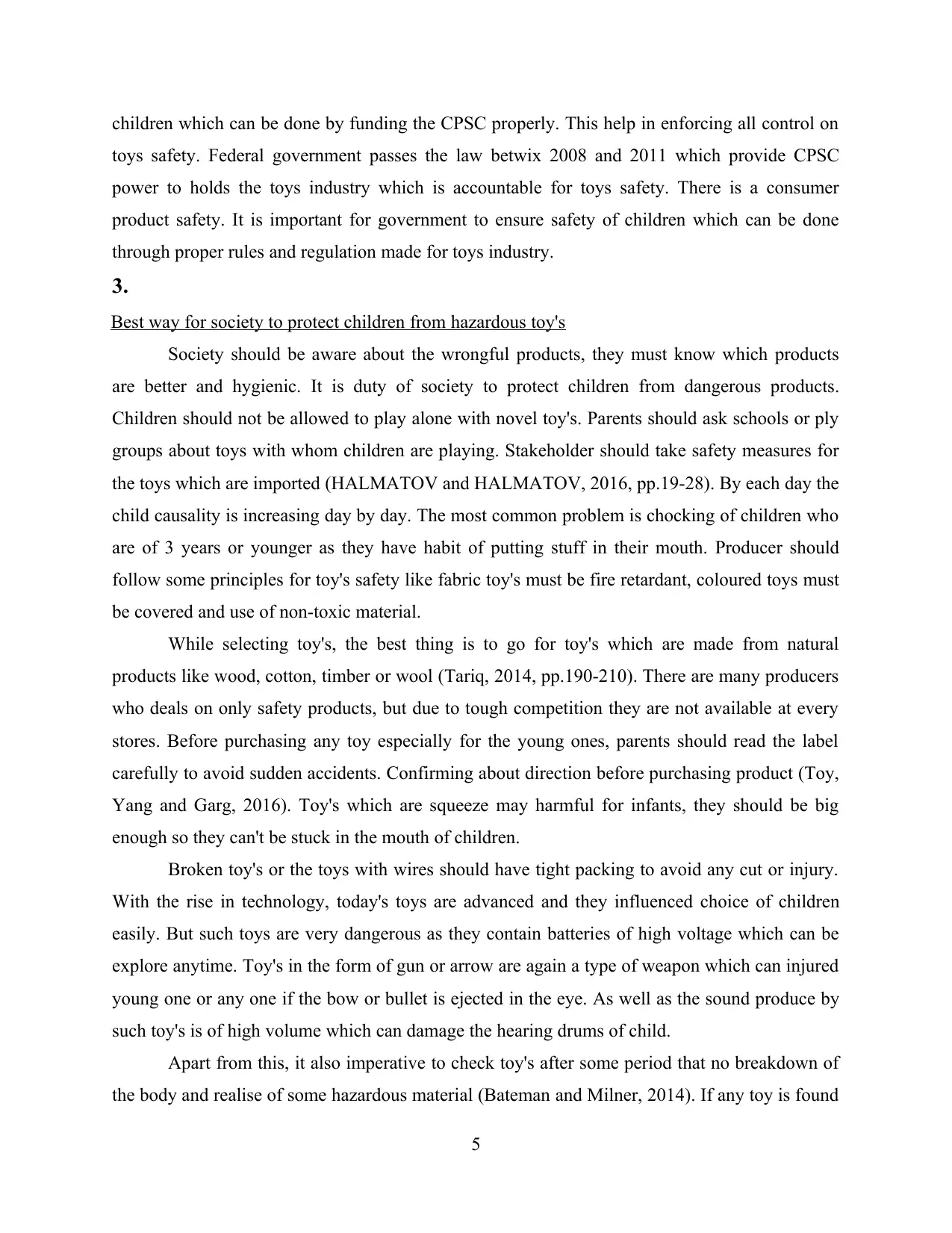
children which can be done by funding the CPSC properly. This help in enforcing all control on
toys safety. Federal government passes the law betwix 2008 and 2011 which provide CPSC
power to holds the toys industry which is accountable for toys safety. There is a consumer
product safety. It is important for government to ensure safety of children which can be done
through proper rules and regulation made for toys industry.
3.
Best way for society to protect children from hazardous toy's
Society should be aware about the wrongful products, they must know which products
are better and hygienic. It is duty of society to protect children from dangerous products.
Children should not be allowed to play alone with novel toy's. Parents should ask schools or ply
groups about toys with whom children are playing. Stakeholder should take safety measures for
the toys which are imported (HALMATOV and HALMATOV, 2016, pp.19-28). By each day the
child causality is increasing day by day. The most common problem is chocking of children who
are of 3 years or younger as they have habit of putting stuff in their mouth. Producer should
follow some principles for toy's safety like fabric toy's must be fire retardant, coloured toys must
be covered and use of non-toxic material.
While selecting toy's, the best thing is to go for toy's which are made from natural
products like wood, cotton, timber or wool (Tariq, 2014, pp.190-210). There are many producers
who deals on only safety products, but due to tough competition they are not available at every
stores. Before purchasing any toy especially for the young ones, parents should read the label
carefully to avoid sudden accidents. Confirming about direction before purchasing product (Toy,
Yang and Garg, 2016). Toy's which are squeeze may harmful for infants, they should be big
enough so they can't be stuck in the mouth of children.
Broken toy's or the toys with wires should have tight packing to avoid any cut or injury.
With the rise in technology, today's toys are advanced and they influenced choice of children
easily. But such toys are very dangerous as they contain batteries of high voltage which can be
explore anytime. Toy's in the form of gun or arrow are again a type of weapon which can injured
young one or any one if the bow or bullet is ejected in the eye. As well as the sound produce by
such toy's is of high volume which can damage the hearing drums of child.
Apart from this, it also imperative to check toy's after some period that no breakdown of
the body and realise of some hazardous material (Bateman and Milner, 2014). If any toy is found
5
toys safety. Federal government passes the law betwix 2008 and 2011 which provide CPSC
power to holds the toys industry which is accountable for toys safety. There is a consumer
product safety. It is important for government to ensure safety of children which can be done
through proper rules and regulation made for toys industry.
3.
Best way for society to protect children from hazardous toy's
Society should be aware about the wrongful products, they must know which products
are better and hygienic. It is duty of society to protect children from dangerous products.
Children should not be allowed to play alone with novel toy's. Parents should ask schools or ply
groups about toys with whom children are playing. Stakeholder should take safety measures for
the toys which are imported (HALMATOV and HALMATOV, 2016, pp.19-28). By each day the
child causality is increasing day by day. The most common problem is chocking of children who
are of 3 years or younger as they have habit of putting stuff in their mouth. Producer should
follow some principles for toy's safety like fabric toy's must be fire retardant, coloured toys must
be covered and use of non-toxic material.
While selecting toy's, the best thing is to go for toy's which are made from natural
products like wood, cotton, timber or wool (Tariq, 2014, pp.190-210). There are many producers
who deals on only safety products, but due to tough competition they are not available at every
stores. Before purchasing any toy especially for the young ones, parents should read the label
carefully to avoid sudden accidents. Confirming about direction before purchasing product (Toy,
Yang and Garg, 2016). Toy's which are squeeze may harmful for infants, they should be big
enough so they can't be stuck in the mouth of children.
Broken toy's or the toys with wires should have tight packing to avoid any cut or injury.
With the rise in technology, today's toys are advanced and they influenced choice of children
easily. But such toys are very dangerous as they contain batteries of high voltage which can be
explore anytime. Toy's in the form of gun or arrow are again a type of weapon which can injured
young one or any one if the bow or bullet is ejected in the eye. As well as the sound produce by
such toy's is of high volume which can damage the hearing drums of child.
Apart from this, it also imperative to check toy's after some period that no breakdown of
the body and realise of some hazardous material (Bateman and Milner, 2014). If any toy is found
5
Paraphrase This Document
Need a fresh take? Get an instant paraphrase of this document with our AI Paraphraser
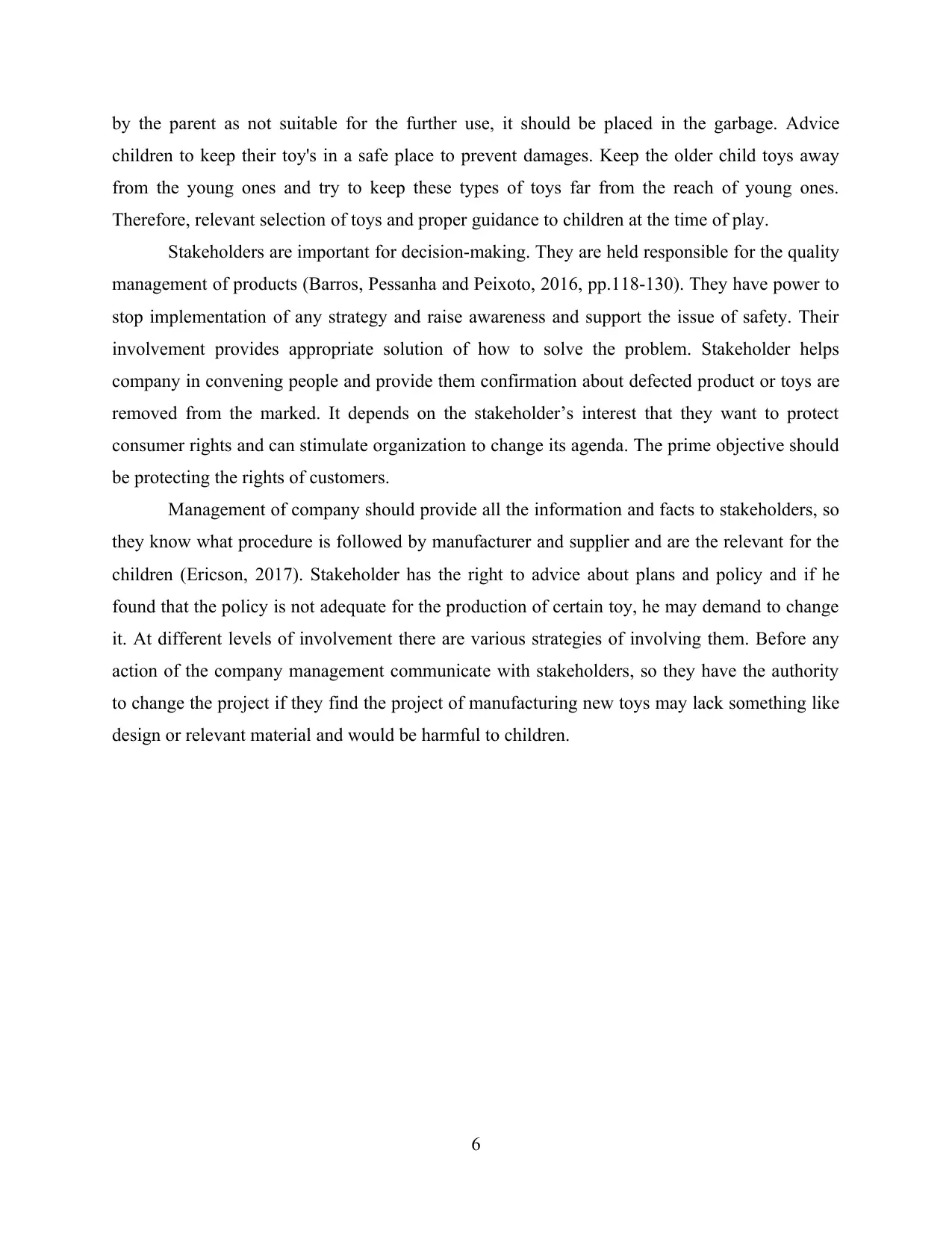
by the parent as not suitable for the further use, it should be placed in the garbage. Advice
children to keep their toy's in a safe place to prevent damages. Keep the older child toys away
from the young ones and try to keep these types of toys far from the reach of young ones.
Therefore, relevant selection of toys and proper guidance to children at the time of play.
Stakeholders are important for decision-making. They are held responsible for the quality
management of products (Barros, Pessanha and Peixoto, 2016, pp.118-130). They have power to
stop implementation of any strategy and raise awareness and support the issue of safety. Their
involvement provides appropriate solution of how to solve the problem. Stakeholder helps
company in convening people and provide them confirmation about defected product or toys are
removed from the marked. It depends on the stakeholder’s interest that they want to protect
consumer rights and can stimulate organization to change its agenda. The prime objective should
be protecting the rights of customers.
Management of company should provide all the information and facts to stakeholders, so
they know what procedure is followed by manufacturer and supplier and are the relevant for the
children (Ericson, 2017). Stakeholder has the right to advice about plans and policy and if he
found that the policy is not adequate for the production of certain toy, he may demand to change
it. At different levels of involvement there are various strategies of involving them. Before any
action of the company management communicate with stakeholders, so they have the authority
to change the project if they find the project of manufacturing new toys may lack something like
design or relevant material and would be harmful to children.
6
children to keep their toy's in a safe place to prevent damages. Keep the older child toys away
from the young ones and try to keep these types of toys far from the reach of young ones.
Therefore, relevant selection of toys and proper guidance to children at the time of play.
Stakeholders are important for decision-making. They are held responsible for the quality
management of products (Barros, Pessanha and Peixoto, 2016, pp.118-130). They have power to
stop implementation of any strategy and raise awareness and support the issue of safety. Their
involvement provides appropriate solution of how to solve the problem. Stakeholder helps
company in convening people and provide them confirmation about defected product or toys are
removed from the marked. It depends on the stakeholder’s interest that they want to protect
consumer rights and can stimulate organization to change its agenda. The prime objective should
be protecting the rights of customers.
Management of company should provide all the information and facts to stakeholders, so
they know what procedure is followed by manufacturer and supplier and are the relevant for the
children (Ericson, 2017). Stakeholder has the right to advice about plans and policy and if he
found that the policy is not adequate for the production of certain toy, he may demand to change
it. At different levels of involvement there are various strategies of involving them. Before any
action of the company management communicate with stakeholders, so they have the authority
to change the project if they find the project of manufacturing new toys may lack something like
design or relevant material and would be harmful to children.
6
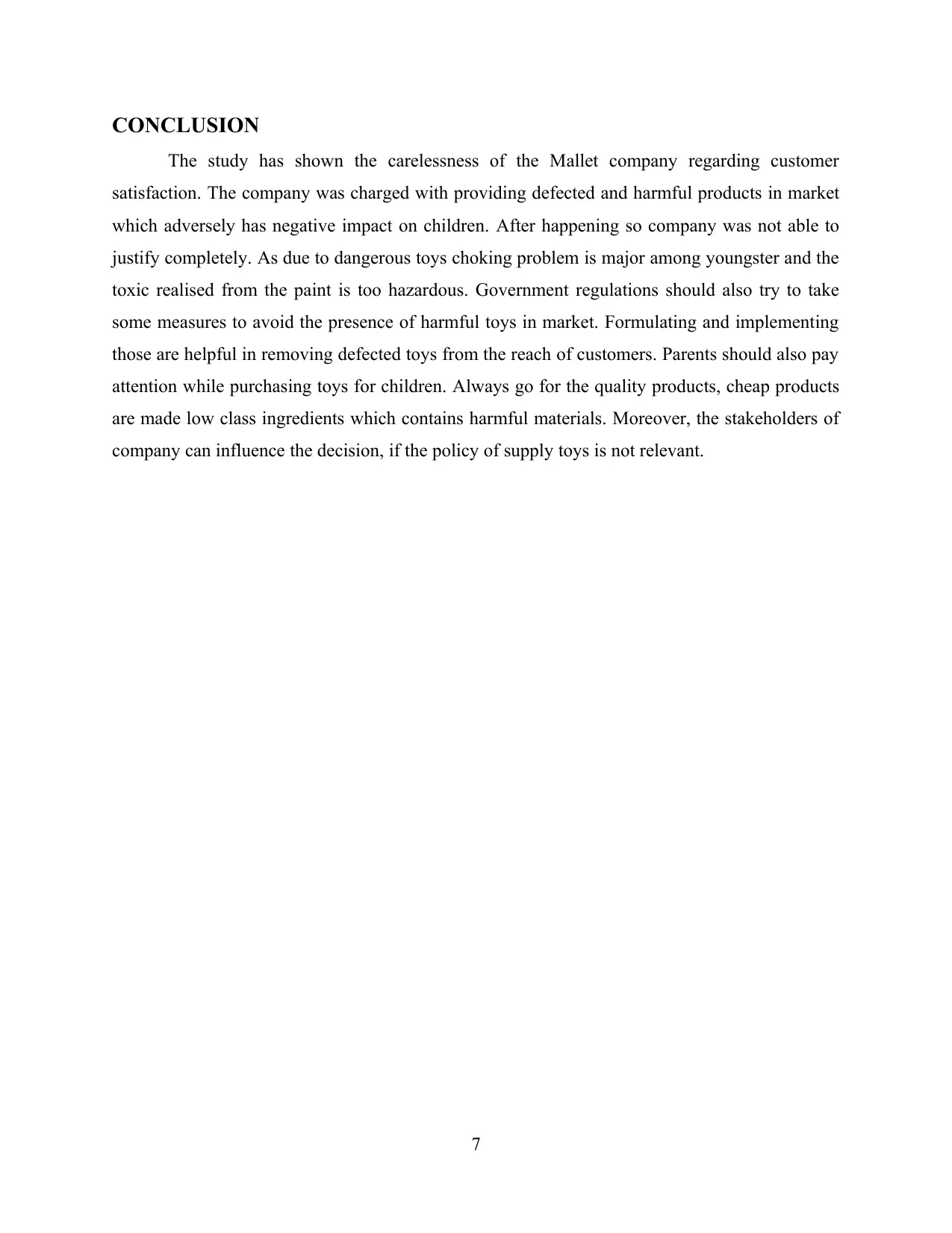
CONCLUSION
The study has shown the carelessness of the Mallet company regarding customer
satisfaction. The company was charged with providing defected and harmful products in market
which adversely has negative impact on children. After happening so company was not able to
justify completely. As due to dangerous toys choking problem is major among youngster and the
toxic realised from the paint is too hazardous. Government regulations should also try to take
some measures to avoid the presence of harmful toys in market. Formulating and implementing
those are helpful in removing defected toys from the reach of customers. Parents should also pay
attention while purchasing toys for children. Always go for the quality products, cheap products
are made low class ingredients which contains harmful materials. Moreover, the stakeholders of
company can influence the decision, if the policy of supply toys is not relevant.
7
The study has shown the carelessness of the Mallet company regarding customer
satisfaction. The company was charged with providing defected and harmful products in market
which adversely has negative impact on children. After happening so company was not able to
justify completely. As due to dangerous toys choking problem is major among youngster and the
toxic realised from the paint is too hazardous. Government regulations should also try to take
some measures to avoid the presence of harmful toys in market. Formulating and implementing
those are helpful in removing defected toys from the reach of customers. Parents should also pay
attention while purchasing toys for children. Always go for the quality products, cheap products
are made low class ingredients which contains harmful materials. Moreover, the stakeholders of
company can influence the decision, if the policy of supply toys is not relevant.
7
⊘ This is a preview!⊘
Do you want full access?
Subscribe today to unlock all pages.

Trusted by 1+ million students worldwide
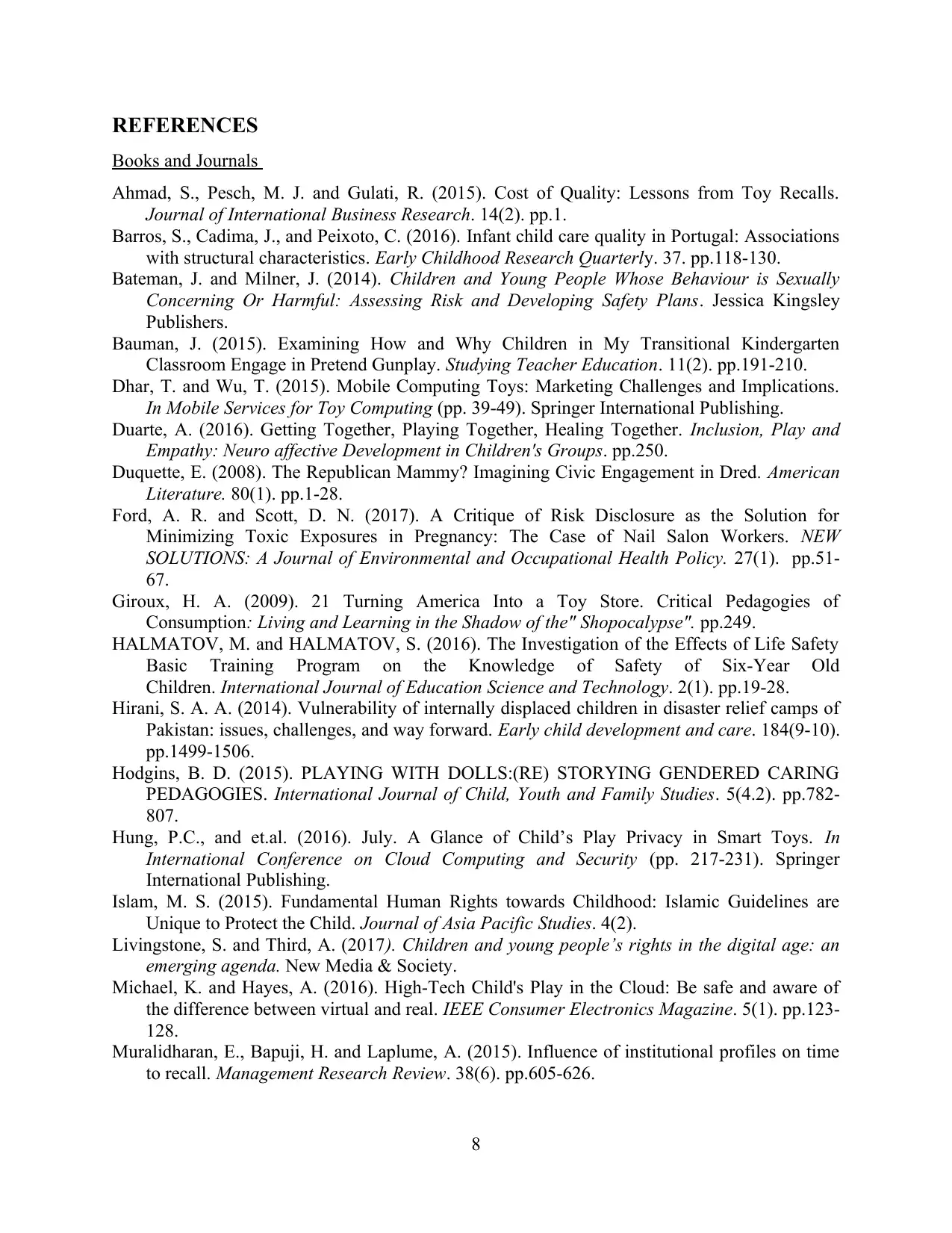
REFERENCES
Books and Journals
Ahmad, S., Pesch, M. J. and Gulati, R. (2015). Cost of Quality: Lessons from Toy Recalls.
Journal of International Business Research. 14(2). pp.1.
Barros, S., Cadima, J., and Peixoto, C. (2016). Infant child care quality in Portugal: Associations
with structural characteristics. Early Childhood Research Quarterly. 37. pp.118-130.
Bateman, J. and Milner, J. (2014). Children and Young People Whose Behaviour is Sexually
Concerning Or Harmful: Assessing Risk and Developing Safety Plans. Jessica Kingsley
Publishers.
Bauman, J. (2015). Examining How and Why Children in My Transitional Kindergarten
Classroom Engage in Pretend Gunplay. Studying Teacher Education. 11(2). pp.191-210.
Dhar, T. and Wu, T. (2015). Mobile Computing Toys: Marketing Challenges and Implications.
In Mobile Services for Toy Computing (pp. 39-49). Springer International Publishing.
Duarte, A. (2016). Getting Together, Playing Together, Healing Together. Inclusion, Play and
Empathy: Neuro affective Development in Children's Groups. pp.250.
Duquette, E. (2008). The Republican Mammy? Imagining Civic Engagement in Dred. American
Literature. 80(1). pp.1-28.
Ford, A. R. and Scott, D. N. (2017). A Critique of Risk Disclosure as the Solution for
Minimizing Toxic Exposures in Pregnancy: The Case of Nail Salon Workers. NEW
SOLUTIONS: A Journal of Environmental and Occupational Health Policy. 27(1). pp.51-
67.
Giroux, H. A. (2009). 21 Turning America Into a Toy Store. Critical Pedagogies of
Consumption: Living and Learning in the Shadow of the" Shopocalypse". pp.249.
HALMATOV, M. and HALMATOV, S. (2016). The Investigation of the Effects of Life Safety
Basic Training Program on the Knowledge of Safety of Six-Year Old
Children. International Journal of Education Science and Technology. 2(1). pp.19-28.
Hirani, S. A. A. (2014). Vulnerability of internally displaced children in disaster relief camps of
Pakistan: issues, challenges, and way forward. Early child development and care. 184(9-10).
pp.1499-1506.
Hodgins, B. D. (2015). PLAYING WITH DOLLS:(RE) STORYING GENDERED CARING
PEDAGOGIES. International Journal of Child, Youth and Family Studies. 5(4.2). pp.782-
807.
Hung, P.C., and et.al. (2016). July. A Glance of Child’s Play Privacy in Smart Toys. In
International Conference on Cloud Computing and Security (pp. 217-231). Springer
International Publishing.
Islam, M. S. (2015). Fundamental Human Rights towards Childhood: Islamic Guidelines are
Unique to Protect the Child. Journal of Asia Pacific Studies. 4(2).
Livingstone, S. and Third, A. (2017). Children and young people’s rights in the digital age: an
emerging agenda. New Media & Society.
Michael, K. and Hayes, A. (2016). High-Tech Child's Play in the Cloud: Be safe and aware of
the difference between virtual and real. IEEE Consumer Electronics Magazine. 5(1). pp.123-
128.
Muralidharan, E., Bapuji, H. and Laplume, A. (2015). Influence of institutional profiles on time
to recall. Management Research Review. 38(6). pp.605-626.
8
Books and Journals
Ahmad, S., Pesch, M. J. and Gulati, R. (2015). Cost of Quality: Lessons from Toy Recalls.
Journal of International Business Research. 14(2). pp.1.
Barros, S., Cadima, J., and Peixoto, C. (2016). Infant child care quality in Portugal: Associations
with structural characteristics. Early Childhood Research Quarterly. 37. pp.118-130.
Bateman, J. and Milner, J. (2014). Children and Young People Whose Behaviour is Sexually
Concerning Or Harmful: Assessing Risk and Developing Safety Plans. Jessica Kingsley
Publishers.
Bauman, J. (2015). Examining How and Why Children in My Transitional Kindergarten
Classroom Engage in Pretend Gunplay. Studying Teacher Education. 11(2). pp.191-210.
Dhar, T. and Wu, T. (2015). Mobile Computing Toys: Marketing Challenges and Implications.
In Mobile Services for Toy Computing (pp. 39-49). Springer International Publishing.
Duarte, A. (2016). Getting Together, Playing Together, Healing Together. Inclusion, Play and
Empathy: Neuro affective Development in Children's Groups. pp.250.
Duquette, E. (2008). The Republican Mammy? Imagining Civic Engagement in Dred. American
Literature. 80(1). pp.1-28.
Ford, A. R. and Scott, D. N. (2017). A Critique of Risk Disclosure as the Solution for
Minimizing Toxic Exposures in Pregnancy: The Case of Nail Salon Workers. NEW
SOLUTIONS: A Journal of Environmental and Occupational Health Policy. 27(1). pp.51-
67.
Giroux, H. A. (2009). 21 Turning America Into a Toy Store. Critical Pedagogies of
Consumption: Living and Learning in the Shadow of the" Shopocalypse". pp.249.
HALMATOV, M. and HALMATOV, S. (2016). The Investigation of the Effects of Life Safety
Basic Training Program on the Knowledge of Safety of Six-Year Old
Children. International Journal of Education Science and Technology. 2(1). pp.19-28.
Hirani, S. A. A. (2014). Vulnerability of internally displaced children in disaster relief camps of
Pakistan: issues, challenges, and way forward. Early child development and care. 184(9-10).
pp.1499-1506.
Hodgins, B. D. (2015). PLAYING WITH DOLLS:(RE) STORYING GENDERED CARING
PEDAGOGIES. International Journal of Child, Youth and Family Studies. 5(4.2). pp.782-
807.
Hung, P.C., and et.al. (2016). July. A Glance of Child’s Play Privacy in Smart Toys. In
International Conference on Cloud Computing and Security (pp. 217-231). Springer
International Publishing.
Islam, M. S. (2015). Fundamental Human Rights towards Childhood: Islamic Guidelines are
Unique to Protect the Child. Journal of Asia Pacific Studies. 4(2).
Livingstone, S. and Third, A. (2017). Children and young people’s rights in the digital age: an
emerging agenda. New Media & Society.
Michael, K. and Hayes, A. (2016). High-Tech Child's Play in the Cloud: Be safe and aware of
the difference between virtual and real. IEEE Consumer Electronics Magazine. 5(1). pp.123-
128.
Muralidharan, E., Bapuji, H. and Laplume, A. (2015). Influence of institutional profiles on time
to recall. Management Research Review. 38(6). pp.605-626.
8
Paraphrase This Document
Need a fresh take? Get an instant paraphrase of this document with our AI Paraphraser
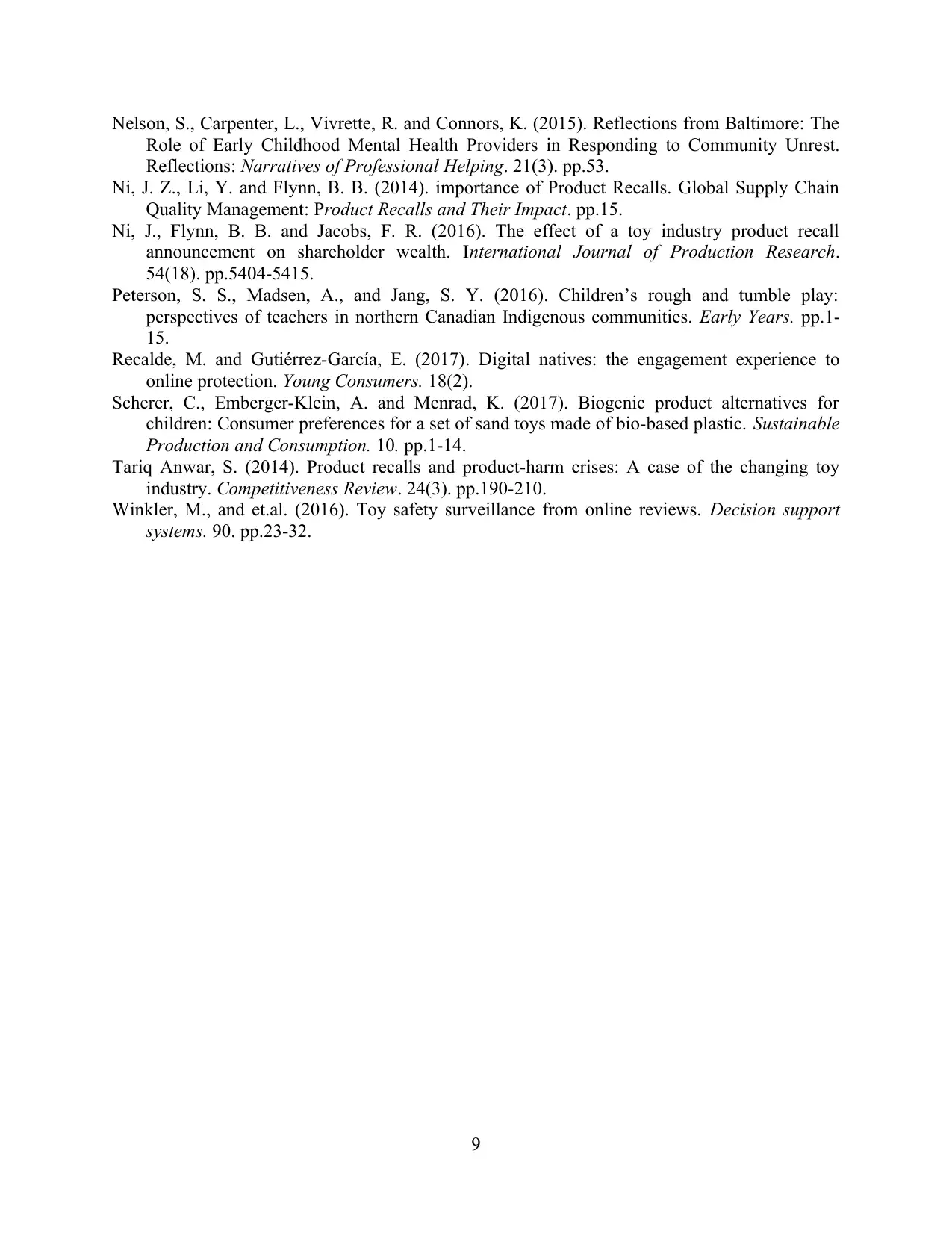
Nelson, S., Carpenter, L., Vivrette, R. and Connors, K. (2015). Reflections from Baltimore: The
Role of Early Childhood Mental Health Providers in Responding to Community Unrest.
Reflections: Narratives of Professional Helping. 21(3). pp.53.
Ni, J. Z., Li, Y. and Flynn, B. B. (2014). importance of Product Recalls. Global Supply Chain
Quality Management: Product Recalls and Their Impact. pp.15.
Ni, J., Flynn, B. B. and Jacobs, F. R. (2016). The effect of a toy industry product recall
announcement on shareholder wealth. International Journal of Production Research.
54(18). pp.5404-5415.
Peterson, S. S., Madsen, A., and Jang, S. Y. (2016). Children’s rough and tumble play:
perspectives of teachers in northern Canadian Indigenous communities. Early Years. pp.1-
15.
Recalde, M. and Gutiérrez-García, E. (2017). Digital natives: the engagement experience to
online protection. Young Consumers. 18(2).
Scherer, C., Emberger-Klein, A. and Menrad, K. (2017). Biogenic product alternatives for
children: Consumer preferences for a set of sand toys made of bio-based plastic. Sustainable
Production and Consumption. 10. pp.1-14.
Tariq Anwar, S. (2014). Product recalls and product-harm crises: A case of the changing toy
industry. Competitiveness Review. 24(3). pp.190-210.
Winkler, M., and et.al. (2016). Toy safety surveillance from online reviews. Decision support
systems. 90. pp.23-32.
9
Role of Early Childhood Mental Health Providers in Responding to Community Unrest.
Reflections: Narratives of Professional Helping. 21(3). pp.53.
Ni, J. Z., Li, Y. and Flynn, B. B. (2014). importance of Product Recalls. Global Supply Chain
Quality Management: Product Recalls and Their Impact. pp.15.
Ni, J., Flynn, B. B. and Jacobs, F. R. (2016). The effect of a toy industry product recall
announcement on shareholder wealth. International Journal of Production Research.
54(18). pp.5404-5415.
Peterson, S. S., Madsen, A., and Jang, S. Y. (2016). Children’s rough and tumble play:
perspectives of teachers in northern Canadian Indigenous communities. Early Years. pp.1-
15.
Recalde, M. and Gutiérrez-García, E. (2017). Digital natives: the engagement experience to
online protection. Young Consumers. 18(2).
Scherer, C., Emberger-Klein, A. and Menrad, K. (2017). Biogenic product alternatives for
children: Consumer preferences for a set of sand toys made of bio-based plastic. Sustainable
Production and Consumption. 10. pp.1-14.
Tariq Anwar, S. (2014). Product recalls and product-harm crises: A case of the changing toy
industry. Competitiveness Review. 24(3). pp.190-210.
Winkler, M., and et.al. (2016). Toy safety surveillance from online reviews. Decision support
systems. 90. pp.23-32.
9
1 out of 11
Related Documents
Your All-in-One AI-Powered Toolkit for Academic Success.
+13062052269
info@desklib.com
Available 24*7 on WhatsApp / Email
![[object Object]](/_next/static/media/star-bottom.7253800d.svg)
Unlock your academic potential
Copyright © 2020–2025 A2Z Services. All Rights Reserved. Developed and managed by ZUCOL.




